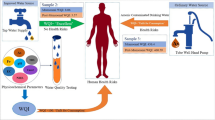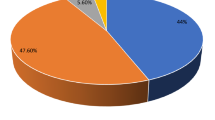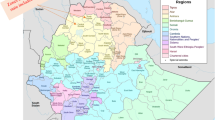Abstract
This study, conducted in Tala Upazila (with > 0.3 million people) situated in a coastal district of Bangladesh, endeavors to identify the water quality situation and to assess people’s willingness to pay for safe drinking water; with a view to develop policies and programs to improve people’s access to safe and affordable drinking water in the coastal area. A total of 4500 households were surveyed for getting relevant information on willingness to pay of households, while water quality test was performed at 649 high dependent drinking water sources (basically tubewells) for identifying arsenic, salinity and iron concentration. Arsenic test results revealed that overall 36.5% of tested drinking water sources; 63% shallow tubewells and 14% deep tubewells were unsafe due to the presence of high levels of arsenic beyond Bangladesh standard. Electrical conductivity, which is a measure of salinity was very high in about 94% of the tested water sources; while 61% of tested sources had iron concentration higher than the Bangladesh standard. It is evident from the study that people are aware of these problems and on an average, 91% of the households were willing to pay for improving access to safe drinking water. Regardless of economic class, most of the households (75%) were willing to pay BDT 20.0 (0.25 USD) per week for 20 L safe water per day, which is equivalent to 2–6% of their respective monthly income to access safe drinking water. Logistic regression model identified monthly household income, tubewell ownership, distance of drinking water source, etc., as some determinants of households’ willingness to pay for safe drinking water. Encouraging peoples who are currently drinking arsenic-contaminated tubewell water to shift their sources to nearby arsenic free tubewells may be a cost-effective solution to this problem. Engaging community-based WatSan committee (a local committee comprising the user communities for supervising water and sanitation related activities) including local government representatives to design an affordable water tariff structure and generating sufficient revenue to cover the cost of water services in the community would be an effective and sustainable solution to improve access of safe and affordable drinking water in the coastal area of Bangladesh.








Similar content being viewed by others
References
Ahmed F, Ahmad N, Khan MA, Jolliffe D, Mahbub MA, Sharif I, Yoshida N, Zaidi S, Swaroop V, Zutt J (2010) Poverty maps of Bangladesh 2010: key findings. World Bank Group, Washington, DC. http://documents.worldbank.org/curated/en/2010/01/20191359/poverty-maps-bangladesh-2010-key-findings
Asim S, Lohano HD, Ahmad I (2015) Households’ willingness to pay for improved tap water services in Karachi, Pakistan/comments. Pak Dev Rev 54(4):507
Bangladesh Bureau of Statistics (BBS) (2013) District statistics 2011. Statistics Division, Ministry of Planning, Government of the Peoples’ Republic of Bangladesh
BBS and UNICEF (2009) Bangladesh multiple indicator cluster survey 2009; Progotir Pathey: final report. BBS and UNICEF Dhaka, Bangladesh
Dey NC, Rabbi S (2013) Use of tubewell water for different purposes at household level: safety practices in rural Bangladesh, In: Achievement of BRAC-WASH program towards Millennium Development Goal and beyond 2013. BRAC, Dhaka, pp 9–30. (Research Monograph 60)
Dey NC, Akter T, Hossain M (2015) Environment: Water, sanitation and hygiene. In: Hossain M, Bayes A (eds) Leading issues in rural development—Bangladesh perspective. AH Development Publishing House, Dhaka, pp 147–163
Dey NC, Parvez M, Dey D, Saha R, Ghose L, Barua M, Islam A, Chowdhury M (2016) Microbial contamination of drinking water from risky tubewells situated in different hydrological regions of Bangladesh. Int J Hyg Environ Health 220(3):621–636. https://doi.org/10.1016/j.ijheh.2016.12.007
Dey NC, Saha R, Parvez M, Bala SK, Islam AKM, Hossain M (2017) Sustainability of groundwater use for irrigation for dry-season crops in the northwest Bangladesh. Groundw Sustain Dev 4:66–77. https://doi.org/10.1016/j.gsd.2017.02.001
Flanagan SV, Johnston RB, Zheng Y (2012) Arsenic in tubewell water in Bangladesh: health and economic impacts and implications for arsenic mitigation. Bull World Health Organ 90(11):839–846
George CM, Zheng Y, Graziano JH, Rasul SB, Hossain Z, Mey JL, van Geen A (2012) Evaluation of an arsenic test kit for rapid well screening in Bangladesh. Environ Sci Technol 46:11213–11219
GoB (National Institute of Population Research and Training), Mitra and Associates, and ICF International (2016) Bangladesh demographic and health survey 2014. NIPORT, Mitra and Associates, and ICF International, Dhaka, Bangladesh, and Rockville, Maryland, USA
Gupta P, Vishwakarma M, Rawtani PM (2009) Assessment of water quality parameters of Kerwa Dam for drinking suitability. Int J Theor Appl Sci 1(2):53–55. http://researchtrend.net/tas12/14%20MONIKA%202.pdf
Hunter PR, MacDonald AM, Carter RC (2010) Water supply and health. PLos Med 7:1–9. www.plosmedicine.org (accessed on 8 November 2015)
Khanom S, Salehin M (2012) Salinity constraints to different water uses in coastal area of Bangladesh: a case study. Bangladesh J Sci Res 25(1):33–42. http://banglajol.ubiquity.press/index.php/BJSR/article/download/13048/9379
Kurokawa M, Ogata K, Idemori M, Tsumori S, Miyaguni H, Inoue S, Hotta N (2001) Investigation of skin manifestations of arsenicism due to intake of arsenic-contaminated groundwater in residents of Samta, Jessore, Bangladesh. Arch Dermatol 137:102–103
Merrill RD, Shamim AA, Ali H, Jahan N, Labrique AB, Schulze K, West KP (2011) Iron status of women is associated with the iron concentration of potable groundwater in rural Bangladesh. J Nutr 141(5):944–949
Misbahuddin M (2015) Arsenicosis: a global issue. Science Publishing Group, New York
OECD (2003) Social issues in the provision and pricing of water services. Organization for Economic Co-operation and Development (OECD) Publishing, Paris
Parry ML, Canziani OF, Palutikof JP, van der Linden PJ, Hanson CE (2007) Climate change 2007: impacts, adaptation and vulnerability. Contribution of Working Group II to the Fourth Assessment Report of the Intergovernmental Panel on Climate Change (eds). Cambridge University Press, Cambridge
Rahman M, Islam MA, Bodrud-Doza M, Muhib MI, Zahid A, Shammi M, Tareq SM, Kurasaki M (2017) Spatio-temporal assessment of groundwater quality and human health risk: a case study in Gopalganj, Bangladesh. Exposure Health. https://doi.org/10.1007/s12403-017-0253-y
Rasheed S, Siddique AK, Sharmin T, Hasan AMR, Hanifi SMA, Iqbal M, Bhuiya A (2016) Salt intake and health risk in climate change vulnerable coastal Bangladesh: what role do beliefs and practices play? PLoS ONE 11(4):e0152783
Rashid MH, Fardous Z, Chowdhury MAZ, Alam MK, Bari ML, Moniruzzaman M, Gan SH (2016) Determination of heavy metals in the soils of tea plantations and in fresh and processed tea leaves: an evaluation of six digestion methods. Chem Cent J 10(1):7
Rebecca D, Merrill RD, Shamim AA, Labrique AB, Ali H, Schulze K, Rashid M, Christian P, West KP (2009) Validation of two portable instruments to measure iron concentration in groundwater in rural Bangladesh. J Health Popul Nutr 27(3):414–418
Sultana M, Saifullah ASM, Latif MB, Mamun SA, Sultana DS (2015) Drinking water quality at academic institutions of Tangail municipality. J Environ Sci Nat Res 6(1):247–252
Tussupova K, Berndtsson R, Bramryd T, Beisenova R (2015) Investigating willingness to pay to improve water supply services: application of contingent valuation method. Water 7(6):3024–3039
WHO (2008) Guidelines for drinking-water quality. Third edition incorporating the first and second addenda. Vol. 1. Recommendations. World Health Organization, Geneva
WHO and UNICEF (2015) Progress on drinking water and sanitation: 2015 update and MDG assessment. WHO/UNICEF Joint Monitoring Program, Switzerland. http://apps.who.int/iris/bitstream/10665/177752/1/9789241509145_eng.pdf
World Bank (2016) Bangladesh development update, October 2016: sustained development progress. World Bank, Washington, DC. © World Bank. https://openknowledge.worldbank.org/handle/10986/25274 License: CC BY 3.0 IGO
Wu J, Wang L, Wang S, Tian R, Xue C, Feng W, Li Y (2017) Spatiotemporal variation of groundwater quality in an arid area experiencing long-term paper wastewater irrigation, northwest China. Environ Earth Sci 76(13):460. https://doi.org/10.1007/s12665-017-6787-2
Acknowledgements
The paper is based on research funded in part by DFID through Strategic Partnership Assistance (SPA) through the BRAC WASH program. We are grateful to participants who provided valuable information for this study. Thanks to WASH program personnel for their contribution during field work. Thanks to the Data Management Unit of RED for providing necessary support for cleaning the data in time. Thanks also to the Center for Water, Environment and Health Research and Development, Social Innovation and Development Foundation for their support during the study.
Funding
The study was funded from DFID through Strategic Partnership Assistance (SPA) through the BRAC WASH program.
Author information
Authors and Affiliations
Contributions
NCD: conceived and conducted the study; analyzed and interpreted the data and wrote the paper. MP: analyzed and interpreted the data, and assisted in report writing. RS: conducted household level survey, assisted in data analysis and GIS mapping. MRI: data analysis and interpretation of data. TA: questionnaire development, training to enumerators, and data collection. MR: coordinated in data collection and reviewed manuscript. MKB: field management during household level survey. AI: field management during household level survey.
Corresponding author
Ethics declarations
Conflict of interest
The authors declare no conflict of interest.
Rights and permissions
About this article
Cite this article
Dey, N.C., Parvez, M., Saha, R. et al. Water Quality and Willingness to Pay for Safe Drinking Water in Tala Upazila in a Coastal District of Bangladesh. Expo Health 11, 297–310 (2019). https://doi.org/10.1007/s12403-018-0272-3
Received:
Revised:
Accepted:
Published:
Issue Date:
DOI: https://doi.org/10.1007/s12403-018-0272-3




